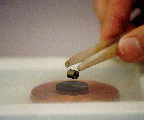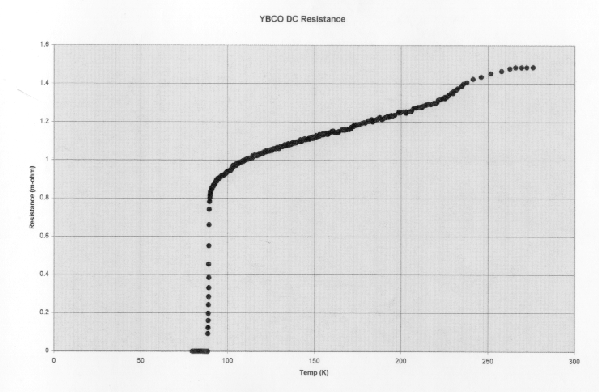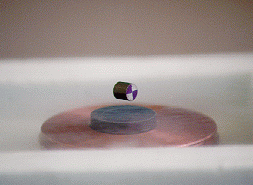

Superconductivity & DC Resistivity
Measurements on a Superconductor
Resistance Results for YBCO:
 The above graph shows the resistance vs. temperature results for the
superconducting sample. The sample that I use is
Yitrium(1)Barium(2)Copper(3)Oxygen(6.95). Unlike Copper, the YBCO pellet
experiences
a phase change on the quantum mechanical level at approximately 90 Kelvin.
At this temperature the electrons begin to form pairs due to a weak
attraction. The attraction between the electrons is a rather amazing feat
considering the fact that the particles involved have like charges. The
attraction is actually a result of the electrons' interaction with the
crystal lattice of the YBCO atoms. As a result of the pairing, the
electrons share the same quantum mechanical wave function. Now if one
electron runs into an impurity in the sample it will only stop if all
of the paired electrons come to a stop. Since a single impurity is
incapable of stopping all of the electrons, the electron in question will
pass the impurity without being scattered. The ramification of this
purely quantum mechanical phenominon is that the sample will have
absolutely
ZERO resistance - a perfect conductor. This can be clearly seen on the
graph where the resistance dives downward as the sample is cooled to below
its transition temperature.
The above graph shows the resistance vs. temperature results for the
superconducting sample. The sample that I use is
Yitrium(1)Barium(2)Copper(3)Oxygen(6.95). Unlike Copper, the YBCO pellet
experiences
a phase change on the quantum mechanical level at approximately 90 Kelvin.
At this temperature the electrons begin to form pairs due to a weak
attraction. The attraction between the electrons is a rather amazing feat
considering the fact that the particles involved have like charges. The
attraction is actually a result of the electrons' interaction with the
crystal lattice of the YBCO atoms. As a result of the pairing, the
electrons share the same quantum mechanical wave function. Now if one
electron runs into an impurity in the sample it will only stop if all
of the paired electrons come to a stop. Since a single impurity is
incapable of stopping all of the electrons, the electron in question will
pass the impurity without being scattered. The ramification of this
purely quantum mechanical phenominon is that the sample will have
absolutely
ZERO resistance - a perfect conductor. This can be clearly seen on the
graph where the resistance dives downward as the sample is cooled to below
its transition temperature.
Perfect Conductivity
So now that we have a sample that is capable of displaying perfect
conductivity, we are in an interesting position with respect to our
previous induction demonstration. If the magnet finally fell onto the
copper after several seconds due to the fact that the copper had some
resistance, what will happen if a magnet is lowered onto a superconducting
sample? As the magnet is brought close, induced currents on the surface
of the superconductor create an opposed magnetic field that attempts to
repel the magnet. When the magnet is close enough, equilibrium is reached
and voila!:
 The magnet never makes it to the surface, IT LEVITATES! It never decends
below the height in the photo because the currents that are responsible
for creating the magnetic field that suspends the magnet never decay away.
The magnet never makes it to the surface, IT LEVITATES! It never decends
below the height in the photo because the currents that are responsible
for creating the magnetic field that suspends the magnet never decay away.
And with a little twist of the wrist...
 The magnet does eventually stop SPINNING due to air friction, but the
LEVITATION goes on forever and ever as long as the sample is kept cold
enough for the electrons to stay paired.
The magnet does eventually stop SPINNING due to air friction, but the
LEVITATION goes on forever and ever as long as the sample is kept cold
enough for the electrons to stay paired.
Actually, to be correct, supercondutors are more interesting than perfect
conductors. In
fact, superconductors are really perfect diamagnets. To see what this
entails you have to check out the last demo on the Meissner
Effect.
Links To and Fro..
Back to the Physics Outreach Home
Page
Back to the Superconductor
Demo Menu
Onward to the Meissner
Effect





